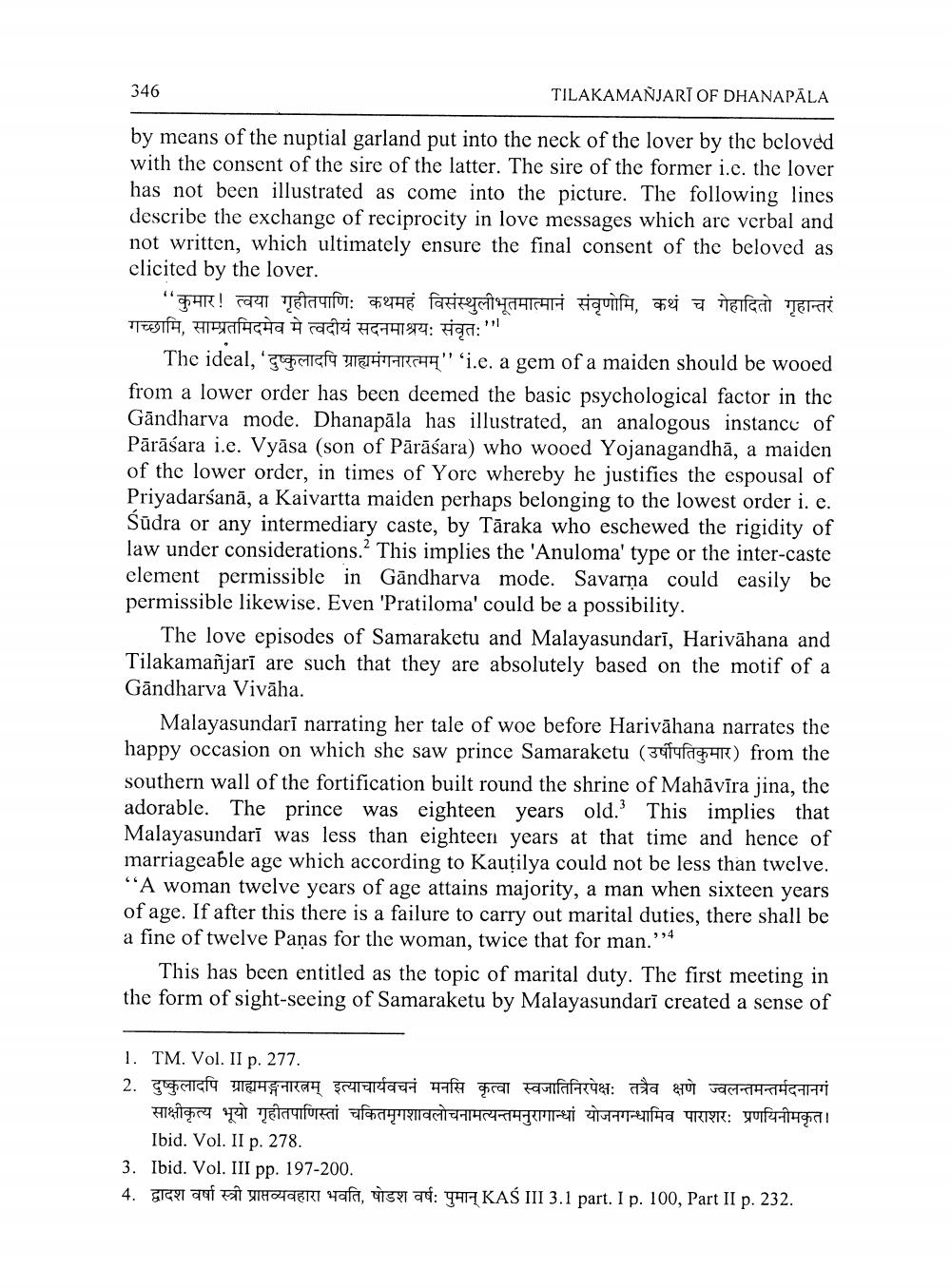________________
346
TILAKAMANJARĪ OF DHANAPĀLA
by means of the nuptial garland put into the neck of the lover by the beloved with the consent of the sire of the latter. The sire of the former i.e. the lover has not been illustrated as come into the picture. The following lines describe the exchange of reciprocity in love messages which are verbal and not written, which ultimately ensure the final consent of the beloved as elicited by the lover.
"कुमार! त्वया गृहीतपाणिः कथमहं विसंस्थुलीभूतमात्मानं संवृणोमि, कथं च गेहादितो गृहान्तरं गच्छामि, साम्प्रतमिदमेव मे त्वदीयं सदनमाश्रयः संवृतः"।
The ideal, 'quicefa MEHTAPC44" 'i.e. a gem of a maiden should be wooed from a lower order has been deemed the basic psychological factor in the Gāndharva mode. Dhanapāla has illustrated, an analogous instance of Pārāśara i.e. Vyāsa (son of Pārāśara) who wooed Yojanagandhā, a maiden of the lower order, in times of Yore whereby he justifies the espousal of Priyadarśanā, a Kaivartta maiden perhaps belonging to the lowest order i. e. Sūdra or any intermediary caste, by Tāraka who eschewed the rigidity of law under considerations. This implies the 'Anuloma' type or the inter-caste element permissible in Gāndharva mode. Savarna could easily be permissible likewise. Even 'Pratiloma' could be a possibility.
The love episodes of Samaraketu and Malayasundarī, Harivāhana and Tilakamañjarī are such that they are absolutely based on the motif of a Gāndharva Vivāha.
Malayasundarī narrating her tale of woe before Harivāhana narrates the happy occasion on which she saw prince Samaraketu (yuraghr) from the southern wall of the fortification built round the shrine of Mahāvīra jina, the adorable. The prince was eighteen years old. This implies that Malayasundarī was less than eighteen years at that time and hence of marriageable age which according to Kautilya could not be less than twelve. “A woman twelve years of age attains majority, a man when sixteen years of age. If after this there is a failure to carry out marital duties, there shall be a fine of twelve Paņas for the woman, twice that for man.”»4
This has been entitled as the topic of marital duty. The first meeting in the form of sight-seeing of Samaraketu by Malayasundari created a sense of
1. TM. Vol. II p. 277. 2. दुष्कुलादपि ग्राह्यमङ्गनारत्नम् इत्याचार्यवचनं मनसि कृत्वा स्वजातिनिरपेक्षः तत्रैव क्षणे ज्वलन्तमन्तर्मदनानगं
साक्षीकृत्य भूयो गृहीतपाणिस्तां चकितमृगशावलोचनामत्यन्तमनुरागान्धां योजनगन्धामिव पाराशरः प्रणयिनीमकृत।
Ibid. Vol. II p. 278. 3. Ibid. Vol. III pp. 197-200. 4. start af M E RT yafa, us91 94: 947 KAŚ III 3.1 part. I p. 100, Part II p. 232.




